Flagship phones may offer wonderful features, but they keep getting more and more expensive. That’s where this list of seven magnificent mid-rangers that cost between £399/$399 and £699/$699 may come in handy.
In the late 2010s, the mid-range market found itself in a rather sorry state, with devices offering sub-par performance, very limited software support, and underwhelming cameras. However, that has changed dramatically over the past couple of years.
These days, buying a mid-range phone on a budget can still land you useful benefits such as a strong camera, beefy battery, muscular performance, and more. Over the past few years, we’ve even seen handy premium features such as wireless charging trickle down into this sector, though it’s still not ubiquitous.
All that said, there is still an enormous quantity of phones to choose from at this price point, and the sheer weight of this selection can make the choice of your new handset a particularly difficult one. That’s why we’ve created this guide, in order to show you the handful of devices we consider to be the very best.
Each phone on this list has been put through its paces for at least one week by an expert reviewer, who has subjected it to benchmark tests as well as assessed its day-to-day performance, in order to give you the best possible idea of how it stands up compared to its peers. We’ve carefully considered the screen quality, processing power, battery life, camera quality, design and robustness of every one of these smartphones, so you can trust our buying advice.
If price isn’t your biggest concern and you’d actually prefer to compare the best top-end phones around, you should check out our best phones guide. On the other hand, if your budget doesn’t stretch as far as the devices listed below, then you can head over to our best cheap phones page to find the most eminently affordable handsets we’d recommend to you right now.
Best mid-range smartphones at a glance
How we test
All the devices in this list have been thoroughly tested and used by one of our expert reviewers. We don’t review a phone purely on specs or benchmark scores and we use them as our everyday device for the review period, which is usually at least five days but often a lot more.
When we review a phone our expert will put their personal SIM card into the phone, sync across their most-used apps and log into all their typical accounts. We do this so you’ll feel confident in our review and trust our verdict.
Our review process includes a mixture of real-world tests, along with more than 15 measured tests and industry-standard benchmarks.
Google Pixel 7a
Best mid-range phone
Pros
- Excellent camera for the price
- Plenty of upgrades over the Pixel 6a
- Smart software
- Some nice colour options
Cons
- Middling battery life
- Achingly slow charging
The Pixel 7a is an impressive mid-range Android phone that combines excellent camera skills, Google’s renowned software, and an affordable price tag. It has quickly become a favourite among the Trusted Reviews staff.
Google’s latest A-series device matches many of the essential features found in its pricier counterpart, the Pixel 7, while also offering several advantages over the Pixel 6a. These advantages include convenient Qi wireless charging, a generous 8GB of memory, a faster 90Hz screen compared to the Pixel 6a’s 60Hz, and a sturdy metal body that improves durability.
The standout feature of the Pixel 7a is, as many would expect from this series, its impressive camera array. Equipped with a new 64MP sensor that’s far larger than the one in the Pixel 6a, it captures exceptional images in various lighting conditions, accurately rendering skin tones. In fact, it’s hard to find a better phone in this price range that can match the camera performance here.
Under the hood, the Pixel 7a is powered by the same Tensor G2 chip found in its higher-end counterparts, the Pixel 7 and Pixel 7 Pro. This chip offers satisfactory performance for its price range and handles the phone’s AI features, such as call screening and voice recording, with ease. There are faster, more capable mid-range phones though – including the Asus Zenfone 9.
It’s worth noting that the Pixel 7a’s battery life is average, and charging is slow. While the phone generally lasts a day, heavy screen usage on busier days might require a quick recharge. A full charge can take over 100 minutes, and a charger needs to be purchased separately.
Overall, the Pixel 7a presents itself as an impressive choice, combining excellent camera capabilities, Google’s software prowess, and an affordable price point.
Reviewer: Max Parker
Full review: Google Pixel 7a
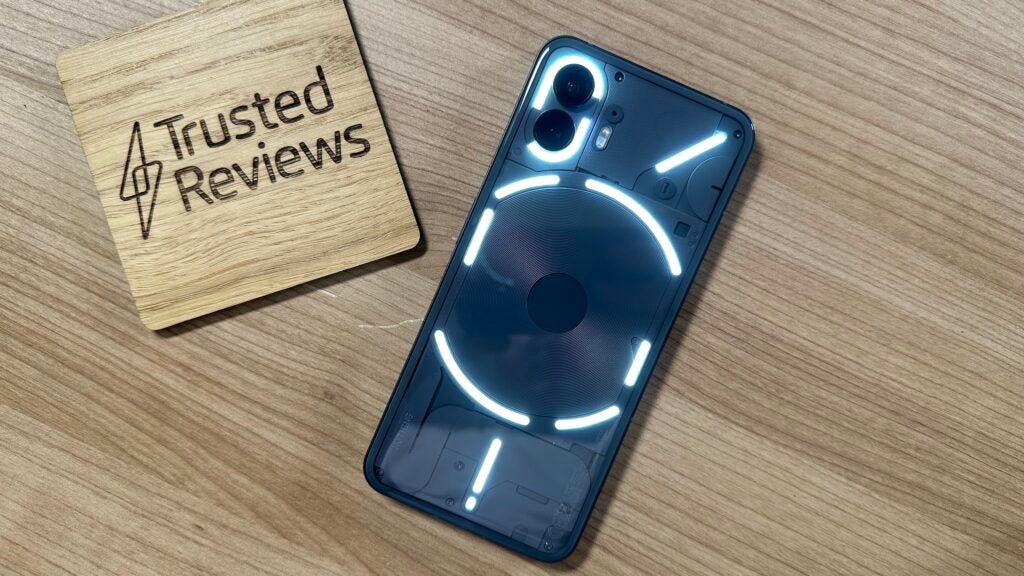
Nothing Phone (2)
Best design
Pros
- Unique LED-laden design
- High-end 6.7-inch OLED display
- Snappy everyday performance
- Capable dual 50MP cameras
Cons
- Camera isn’t great in low-light conditions
- No charger in the box
- Much more expensive than Nothing Phone (1)
If you want a smartphone that stands out from the crowd, look no further than the Nothing Phone (2).
Continuing what was started with the Nothing Phone (1), the latest model sports the same unique transparent look that gives a good look at some of the components powering the phone, and the Glyph interface has made a return too.
The white LED strips on the rear are much brighter this time around and, thanks to improvements in the strips, the light show is much more customisable. That’s further improved by Glyph Composer, a synthesiser-style app that allows you to create your own visual ringtones that sync with the rear lighting panel.
The Glyph interface is still mainly used for alerting you to incoming calls and texts, but it’s handy and, importantly, looks impressive – especially at the mid-range price point.
It’s not just a looker either; it sports the flagship-level Snapdragon 8 Gen 1 for top-end power and efficiency, a 4,700mAh battery with 45W charging that delivers a full charge in under an hour and a dual 50MP rear camera offering.
There’s also Nothing OS 2.0, introducing new features like widget support on both the lock screen and always-on display. It’s heavily stylised with a dot-matrix iconography that won’t be to everyone’s tastes, but as with the hardware, it certainly sets itself apart from the mid-range competition.
Reviewer: Lewis Painter
Full review: Nothing Phone (2) review
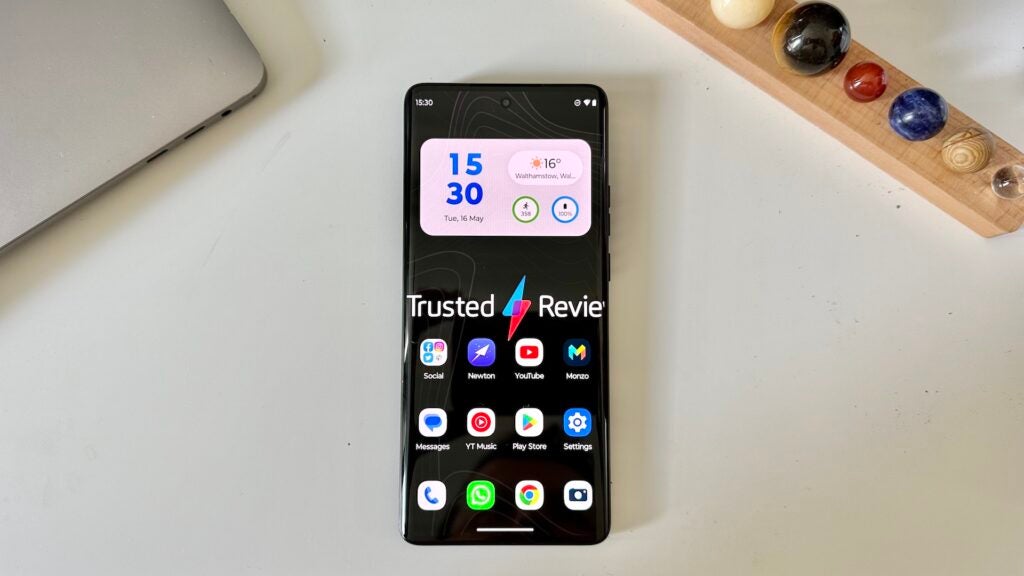
Motorola Edge 40
Best mid-range Motorola phone
Pros
- Svelte, lightweight design
- Vibrant, fast 144Hz pOLED display
- Versatile main camera performance
- Fast 68W TurboPower charging
Cons
- Can overheat when playing games
- A few bugs within the OS
- Refresh rate has to be fixed at 144Hz if used
Motorola’s mid-range Edge 40 is a strong option for prospective buyers, offering not only a sleek, svelte design but impressive camera performance, a gorgeous display and fast 68W charging tech for £529.
The design of the Edge 40 is unique, sporting a vegan leather rear that completely encompasses the rear including the camera housing, with the material also proving to be grippy enough to wield the 6.55-inch phone one-handed without much issue. It’s also one of the thinner and lighter options around at 7.6mm and 172g respectively.
The display is rapid at 144Hz, with pOLED tech delivering the vibrant colours and inky blacks expected of the tech – it’s just a shame that the 144Hz refresh rate is locked, with the auto-refresh rate option only cycling between 60- and 120Hz.
The main 50MP rear camera has the widest aperture around at f/1.4, and combined with PDAF and OIS, takes impressive low-light photos for the money. It also adds a nice natural bokeh to most images with a relatively shallow depth of field. The ultra-wide isn’t quite as capable, however, and the selfie camera delivered consistently washed-out images.
Things aren’t quite as rosy when it comes to performance though; the Dimensity 8020 chipset is more than enough to power the day-to-day experience without lag, but the phone can quickly overheat when playing demanding games like Call of Duty Mobile leading to lag and framerate drops.
Reviewer: Lewis Painter
Full review: Motorola Edge 40
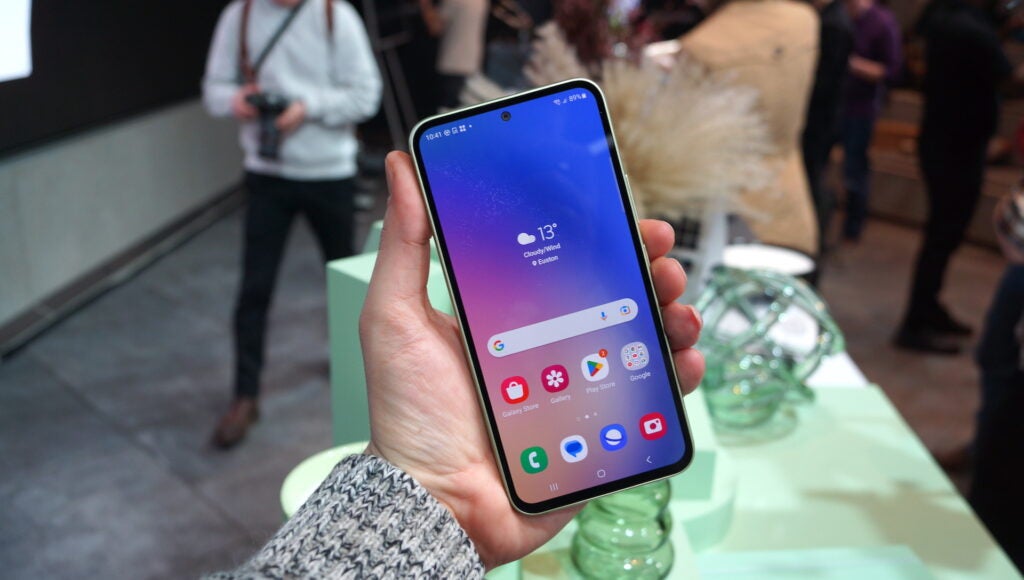
Samsung Galaxy A54 5G
Best mid-range Samsung phone
Pros
- Premium look and build
- Great 120Hz AMOLED display
- Huge 5,000mAh battery
- New and improved 50MP camera
Cons
- Inconsistent battery life
- No display HDR support
- Can be a bit slow at times
- Slow charge times
If you’re a Samsung purist and your budget can’t quite stretch to the £849 Samsung Galaxy S23, the more budget-friendly £449 Galaxy A54 5G might suit your needs.
It sports a near-identical design to the flagship Galaxy S23 series complete with rounded edges and a minimalistic camera setup on the rear, and even makes the jump to a glass rear for an added premium feel, though it’s let down somewhat by the polycarbonate frame.
Netflix bingers and social media addicts will love the 6.4-inch 120Hz AMOLED display, delivering vibrant colours and deep blacks. It’s just as good for gaming, though with the distinctly mid-range Exynos 1380 chipset, it’s more limited to 2D titles than AAA 3D games like Call of Duty Mobile with top-end graphics enabled.
Though it may seem like a downgrade on paper compared to the 64MP snapper of its predecessor, the A54 5G’s 50MP main lens has a larger sensor and improved OIS that leads to notable improvements in low-light photography, though it can’t quite compete with the Pixel 7. That’s flanked by an ultrawide and macro lens, but the main lens is where most of the attention is.
The inclusion of a 5000mAh battery is welcome, matching the top-end S23 Ultra and beating the flagship S23 and S23 Plus, but battery life is a bit hit-and-miss in real-world conditions. It has the potential to last all day with average use, but pushing the A54 5G to its limits will leave you scrambling for a charger. And, with 25W charging, it takes quite some time to charge too.
Reviewer: Lewis Painter
Full review: Samsung Galaxy A54 5G
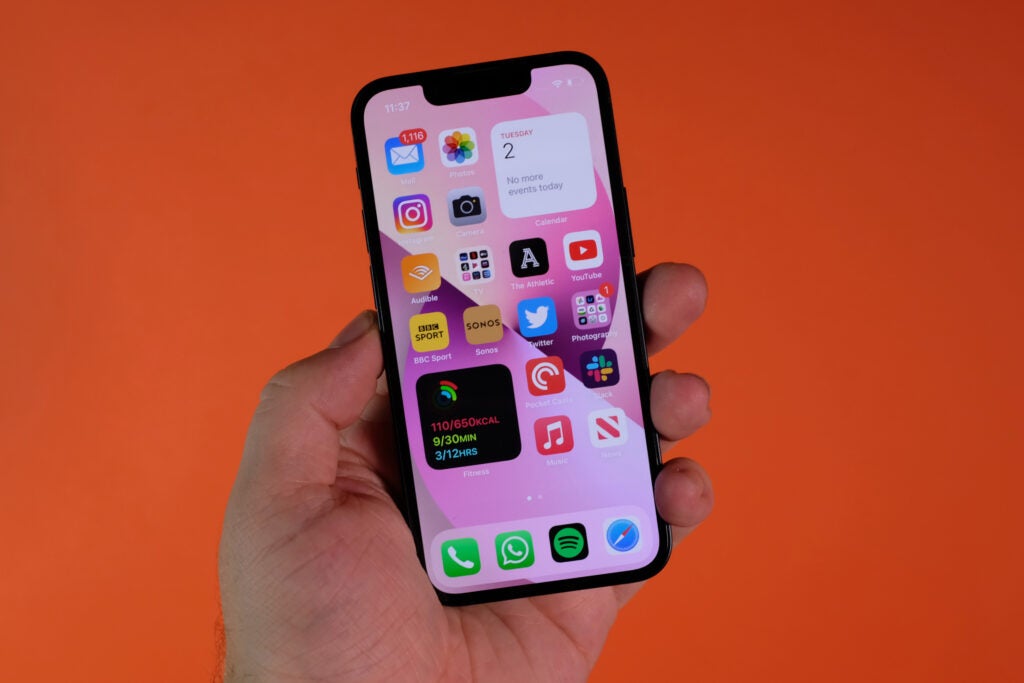
iPhone 13 Mini
Best iPhone under £700/$700
Pros
- Great camera
- Better battery life than the previous Mini
- The most powerful small phone around
Cons
- No ProMotion
- No optical zoom
- Still can’t compete with the other iPhone 13 models for battery life
If you’re an Apple fan, and dead-set on getting an iPhone, then there are a couple of options on the market at the moment. At £779, the regular iPhone 13 is too expensive for what we consider a mid-range phone, so that’s crossed off the list. But the cheaper iPhone 13 Mini is within budget and a great choice if you want a smaller device.
You’ve got to be really comfortable with this smaller form factor to enjoy the iPhone 13 Mini, and it probably isn’t for those who watch a lot of media or play lots of games on the go. We found the screen is too small for that.
But, if you use your phone more for messaging, social media and taking pictures then the smaller size might be of benefit. It’s also the most comfortable phone to use one-handed on this list, especially if you’ve got smaller hands.
Feature-wise, the iPhone 13 Mini is the same as the pricier iPhone 13. Performance is the best out of any mid-range phone both in stringent lab tests and real-world use, while the duo of cameras on the back are the only ones listed that can compete with the Pixel 6. You’ll also get multiple years of support through iOS updates.
Wireless charging is here, as is an IP68 rating for dust and water resistance. It’s also just a very nice looking phone, with multiple tasteful colour options available.
If you want a cheaper iPhone, the iPhone SE 2022 packs the same high-end performance but in a slightly dated body with a smaller screen.
Reviewer: Max Parker
Full review: iPhone 13 Mini Review
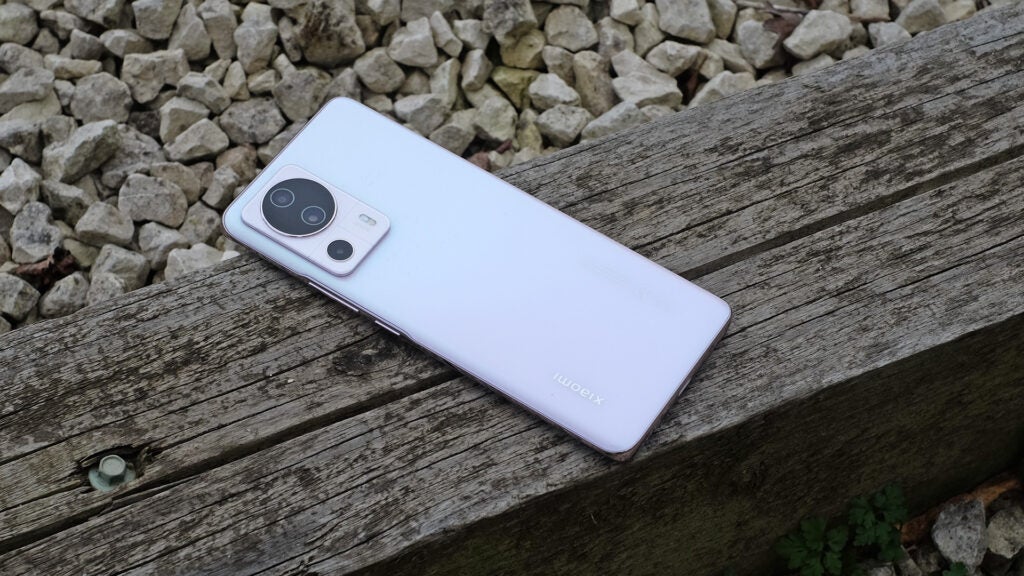
Xiaomi 13 Lite
Best for design
Pros
- Premium look and feel
- Great main camera performance
- Decent everyday performance
Cons
- MIUI can be frustrating to use
- Photos can appear oversaturated
- Only lasts a day with comfortable use
As the name suggests, the Xiaomi 13 Lite is a cheaper version of the excellent Xiaomi 13 – one of our favourite Android phones of the year so far.
Our reviewer was thoroughly impressed with the design here, praising the curved looks and thin overall build. But it impressed in other areas too, even bettering the pricier Xiaomi 13 when it came to the selfie camera.
It has a bright OLED display too, a really impressive main rear camera that beats many entries on this list even if it can, at times, oversaturate images. If you like the blurry, bokeh-influenced selfies too this is a winner.
There’s snappy 67w charging that can take it from 0-100% in less than 45 minutes and generally battery life that got our reviewer comfortably through the day.
Reviewer: Andrew Williams
Full review: Xiaomi 13 Lite review
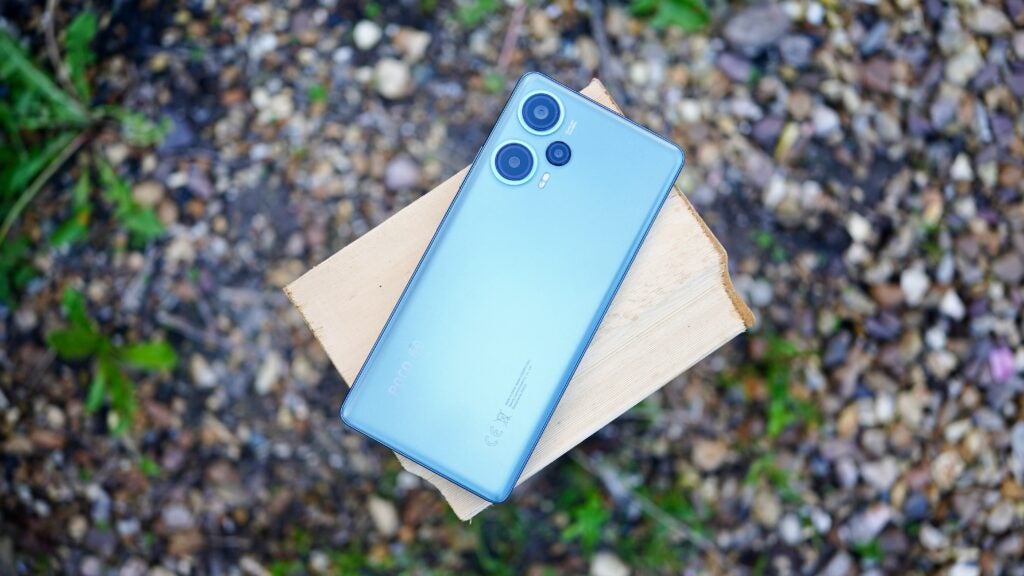
Pros
- Excellent performance
- Strong AMOLED screen
- Refined (if still not exciting) design
Cons
- More expensive than before
- MIUI 14 is still hard work
- Camera remains so-so
The Poco F5 is the latest mid-ranger from the Xiaomi sub-brand and has a distinct focus on performance and entertainment with decent performance and a strong display experience at just £449.
The star of the show is the 6.67-inch OLED display which we found to be plenty bright at a boosted 100nits and, as expected from OLED tech, the colours are accurate and blacks inky, making it a great option for binging movies on Netflix on the move.
It also has a 120Hz refresh rate and 240Hz touch sample rate that should appeal to gamers, especially when paired with the other key feature; the latest Snapdragon 7 Plus Gen 2 chipset, the only smartphone in our list to boast the tech. We found that the chipset could comfortably outpace the Snapdragon 8 Plus Gen 1 found in the Poco F5 Pro in the CPU department, with decent GPU performance too.
Other key features include a healthy 5000mAh battery with fast 67W wired charging that saw a full charge in 52 minutes, 256GB of storage and 12GB of RAM as standard and 5G connectivity too. It’s just a shame that the so-so camera offering remains largely the same as the Poco F4 and MIUI 14 remains as cluttered as ever or it’d be an easy recommendation for most.
Reviewer: Jon Mundy
Full review: Poco F5 review
FAQs
The team at Trusted Reviews defines mid-range smartphones as any handset costing ideally under £700/$700. We raised our definition in 2022, following a gradual rise in prices in the top end of the market.
Over the last few years, the mid-range phone market has blossomed, with key companies including Google, Xiaomi, OnePlus, Oppo and Samsung creating mid-range handsets with features traditionally reserved for flagship devices. Recent highlights have included 5G connectivity, high refresh rate screens and improved rear camera sensors. The team of experts at Trusted Reviews recommend most users consider a mid-range smartphone before investing in a flagship as a result.
5G is an increasingly common site in the mid-range market with Samsung, Oppo, Motorola, OnePlus and Google having mid-range phones supporting the connectivity.
Specification comparison
UK RRP
USA RRP
EU RRP
CA RRP
AUD RRP
Manufacturer
Screen Size
Storage Capacity
Rear Camera
Front Camera
Video Recording
IP rating
Battery
Wireless charging
Fast Charging
Size (Dimensions)
Weight
Operating System
Release Date
First Reviewed Date
Resolution
HDR
Refresh Rate
Ports
Chipset
RAM
Colours
Stated Power
Geekbench 5 single core
Geekbench 5 multi core
Geekbench 6 single core
Geekbench 6 multi core
sRGB
Adobe RGB
DCI-P3
Max brightness
1 hour video playback (Netflix, HDR)
30 minute gaming (intensive)
30 minute gaming (light)
1 hour music streaming (online)
1 hour music streaming (offline)
Time from 0-100% charge
Time from 0-50% charge
30-min recharge (included charger)
15-min recharge (included charger)
30-min recharge (no charger included)
15-min recharge (no charger included)
3D Mark – Wild Life
3D Mark – Wild Life Stress Test
GFXBench – Aztec Ruins
GFXBench – Car Chase











